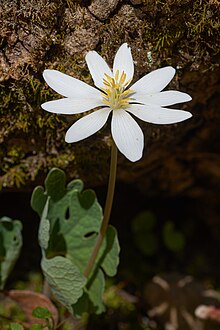| Sanguinaria | |
|---|---|

| |
| Scientific classification | |
| Kingdom: | Plantae |
| Clade: | Tracheophytes |
| Clade: | Angiosperms |
| Clade: | Eudicots |
| Order: | Ranunculales |
| Family: | Papaveraceae |
| Subfamily: | Papaveroideae |
| Tribe: | Chelidonieae |
| Genus: | Sanguinaria L. |
| Species: | S. canadensis
|
| Binomial name | |
| Sanguinaria canadensis L.
| |
Sanguinaria canadensis, bloodroot,[3] is a perennial, herbaceous flowering plant native to eastern North America.[4] It is the only species in the genus Sanguinaria, included in the poppy family Papaveraceae, and is most closely related to Eomecon of eastern Asia.
Sanguinaria canadensis is sometimes known as Canada puccoon,[5] bloodwort, redroot, red puccoon, and black paste.[4] Plants are variable in leaf and flower shape, and have been separated as a different subspecies due to these variable shapes, indicating a highly variable species.
In bloodroot, the sap is red and poisonous.[4][6] Products made from sanguinaria extracts, such as black salve, are escharotic and can cause permanent disfiguring scarring.[4] If applied to the skin, the extract sanguinarine may cause a massive scab of dead flesh where it killed the cells, called an eschar.
Although there are laboratory studies indicating that sanguinaria may have potential in cancer therapy, clinical studies are lacking, and its use is discouraged due to significant toxicity.[4]
- ^ Siekkinen, K., Reinier, J. E., Meredith, C.R., Williams, M., Piatt, L., Mikanik, A., Leopold, S., Gerrity, J., Dinh, D., Duncan, H., Kirchner, W., Metzman, H., Miller, A. & Preston, J. (2024). "Sanguinaria canadensis". IUCN Red List of Threatened Species. 2024: e.T107292458A107292584. Retrieved 12 August 2024.
{{cite journal}}: CS1 maint: multiple names: authors list (link) - ^ NatureServe (1 September 2023). "Sanguinaria canadensis". NatureServe Network Biodiversity Location Data accessed through NatureServe Explorer. Arlington, Virginia: NatureServe. Retrieved 9 September 2023.
- ^ "Sanguinaria canadensis". Germplasm Resources Information Network. Agricultural Research Service, United States Department of Agriculture. Retrieved 12 December 2017.
- ^ a b c d e "Bloodroot". Drugs.com. 22 March 2021. Retrieved 1 June 2021.
- ^ "RHS Plantfinder - Sanguinaria canadensis". Retrieved 28 October 2018.
- ^ "Bloodroot Wildflowers". Wild Flowers Guide. Archived from the original on 2014-08-21.

